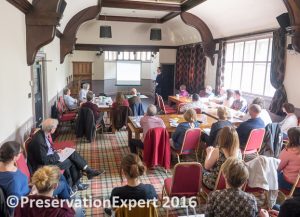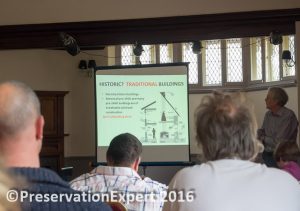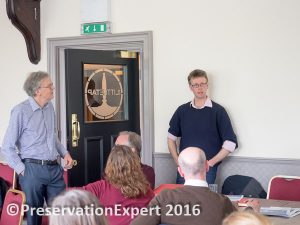Retro-Fit Insulation Traditional Buildings.
I was a guest at the Yorkshire branch AGM of the Institute of Historic Building Conservation today. The AGM was for members only, but it was preceded by two fascinating presentations, which I sat in on.
John Preston gave a presentation on the Impact of Retrofit insulation on traditional Buildings. Nick Heath gave a presentation entitled Solid Wall Insulation Research – issues an guidance.
Impact of retrofit insulation traditional buildings
The rush to combat climate change has seen application of EWI across the county. John took delegates through the Green Deal and ECO delivery methods, highlighting the extent of money and resources thus far applied to schemes. He covered the legal framework and in particular the disparity between existing standards and building regulations, when compared to the standards being applied ‘across the board’ to retrofit insulation.
As Vive-Chair of IHBC policy committee and the heritage chair of the Sustainable Traditional Building Alliance (STBA), John is at the heart of the drive to bring all stakeholders together to help reduce the potential harm retrofit can do to traditional buildings and to obtain full benefit at the same time. This is no easy task, as the rush to get funds spent and meet CO2 targets has seen the requirements of traditional buildings side-lined thus far.
I was surprised to find that over 30% of the existing building stock is solid wall construction. John confirmed that it is not just those in the ‘accepted’ 1919 cut-off, but a great many more houses, right up to WW2.
That is an awful lot of solid walls houses, which will have their temperature and air quality drastically changed, as the retrofit revolution gathers pace. However, John also highlighted the important new BRE research, which has surprised many by indicating that many older solid walls are in fact much better insulators than was thought. It is clear that huge gains can be made just by carrying out simple maintenance. Combine this with sensible internal, permeable insulation and controlled ventilation and great progress can be made.
Solid Wall Insulation Research – issues and guidance
Nick Heath’s presentation was a real eye-opener for some delegates. His initial approach was to show us the awful results of poor practice in retrofit. Mouldy and damp stained walls, often in houses of those most ill able to cope with the problem are common.
It was clear the burgeoning industry, grown to satisfy the urgent demand is having problems. Poor design is one obvious issue. The failure to take onto account traditional fabric another. That said, Nick was also quick to praise the efforts many are putting in to getting these things right, so it isn’t all bad.
It struck a chord with me because I do see a parallel here, between the past problems with cavity wall insulation. These things seem to follow government money streams – targets have to be met fast and often funding groups literally lose money, if it is not for example spent by March 30th. No wonder retrofit is pushed on houses ‘on mass’ with no time or inclination, to treat houses individually.
The issues of cold bridges left by gaps was highlighted. The side effects of increasing air-tightness, whilst not looking at the mechanical extraction needs are clear – to some. This floats my boat as I find that the most common cause of mould later on, after any improvement scheme is a lack of information for owners and tenants. One example being that if a cheap extractor fan is fitted, it will start to rattle in a year or two. The tenants, not realising the crucial part the fan has in managing their home environment, simply turn it off at the isolator switch. The resultant presence of mould is not connected to the redundant fan, which has been forgotten. I wrote a post some years back just because I spend so much time answering tenants who ask “Why is my house damp”?
I enjoyed the presentation and the company of these professionals immensely. As the only ‘damp specialist’ there, it could have been a little like being in the lions den. In fact what I found were a bunch of enthusiastic, knowledgeable and dedicated people, many of whom had travelled a long way for these presentations. On a sunny Saturday in York, people were learning to do their work better and help their clients – outstanding.
John and Nick are guest speakers at the Property Care Association AGM next week in Cambridge. I’m looking forward to seeing them. The PCA members are in for a treat.
One quote must get an airing though “All you need is a person standing in front of the building, with a brain” a quote from Nick’s presentation, by Colin King Director BRE Wales. Priceless and so apt, for much much more than just retrofit insulation.
Dry Rot.
PS – My thanks go to David Rawlins, who kindly invited me along. Why not pop along to the IHBC web site and consider membership? After the above meeting I am 🙂
Surveying traditional buildings for damp and timber preservation issues, needs a sound understanding of them. For those who own properties in Yorkshire, I can help with sound, practical and expert advice – my day job is running the multi award winning PCA member company Brick-Tie Limited. 30 years of structural repairs and damp related work on traditional buildings in Yorkshire.




Great report Bryan. Many thanks.
As an octogenarian when I stand in front of a building I ask; why did they build it like this?
Usually something has gone wrong.
Like, let us throw out that “tin junk” in the roof, and bung up those holes in the wall. This means the passive ventilation system has been destroyed with resultant mould on the walls.
Let us put in rattling fans and use more electricity !
Please keep reporting, I now have to read it again, and pick up the links
Peter.